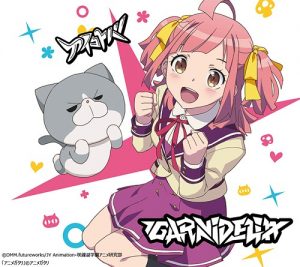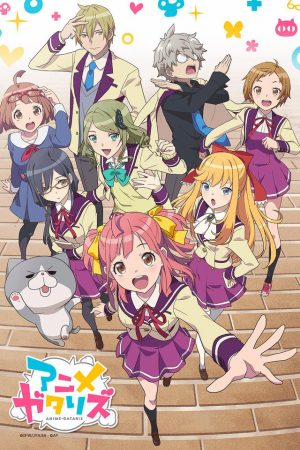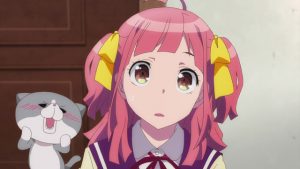Anime-Gataris is one of those gems that feel like a love letter to the anime community. The story revolves around Minoa Asagaya and the members of the anime club at her high school. We get the chance to see the anime club get caught up in all the classic slice-of-life tropes. The best part is that the club recognizes and comments on the tropes in genuine fourth-wall-breaking fun. We love anime that give that look inward at the otaku community. Anime-Gataris hits you over the head with a softball bat with cliché after cliché making fun of things we otaku do or places we long to go. We at Honey’s Anime appreciate that the writers are fans of anime and are a lot like us. In recognition, we have compiled a list of the Top 10 Otaku Monuments in Anime-Gataris.
10. What’s That Called Again?
We all have that one show that we absolutely loved but can’t remember the name. A search of the internet comes back with about a thousand possibilities because we put what we can remember in the search box and hit enter. We quickly find out that a lot of anime take place in schools, have robots, or time travel. We ask our friends online and they can’t remember either. A trip to a convention has us searching a crowd for a costume in the hopes that we find someone that looks right. We eventually stumble across “In Search of the Lost Future” and wonder “how did I forget that?”
A similar scenario happens to Minoa, the main character of Anime-Gataris. She is wracked with dreams of an anime she saw when she was younger and asks a friend about it. The friend hasn’t a clue, but more than one closeted otaku in the class hears her question and their curiosity is piqued. Minoa falls down the otaku rabbit hole and is swept up in events that bring her friends an adventure in her first year of high school.
9. Um Excuse Me. Did You Say…?
You’ve probably had this experience. You’re standing in line at the store, the bank, the movies and you hear a familiar word, or name, or spot a pin or badge on a backpack in front of you and can’t resist the urge to comment something like “You like Modoka? What did you think of the movie? I was confused at first but watched it like 3 times. You?” Sometimes they’re into it and you find a kindred spirit, others time they look at you really weird, especially if you’re over 40. The problem is you can’t resist the need to engage; you’re an anime addict or in other terms an Otaku.
The first episode of this series has a very similar scenario. In school, Minoa mentions an anime and we see two other girls in the class pretending to ignore her, but they can’t. She is approached by the school’s most beautiful girl, Arisu, and told to meet her in the art room after class. They ask Minoa “Do you like anime?” When the answer is yes, Arisu kind of loses it as anime talk just begins to spill out of her like water from a dam that’s been held back after a hard rain. You understand this as an anime fan and are probably guilty of becoming overly excited when you hear someone say they watch anime.
8. The book was better. No, the anime was.
Is the book better than the show? The argument isn’t exclusive to anime, but otaku are often extremely passionate about their stances. There can also be some elitism mixed in; the idea that you’re not a real fan if you don’t read the light novel associated with the television show. The novel can help you figure things out sometimes, things that aren’t well described in the anime or are too naughty for TV.
We have this argument between Arisu and bespectacled Miko as the anime club is being formed. Miko likes to read the light novels and thinks they open doors and avenues to the characters that you don’t get in the anime. Arisu only seems to look at the novels as a potential diversion from the truth of the anime. The argument almost tears the club apart before it gets started. Minoa steps in to be the peacemaker, reminding Arisu and Miko that they both have been looking for people to share their love of anime.
7. It’s not just a silly kids show…
We older otaku often feel pressured to explain why we love what many uneducated people believe are just silly cartoons. Yes, we like them because they’re silly at times, but they can also be dramatic or filled with action. You find yourself using the term “art” a lot in your explanations, talking about how the motion is fluid or the blend of computer-generated animation and painted cells is seamless. We try to explain tropes and why tropes are like a cultural shorthand or an architype. Yet, in some cases we have no way to justify that we just like to watch cute cat-girls fawn over their masters.
The anime club defends itself against being shut down by the student council for being a frivolous enterprise. The club, like us, has to justify their love of anime. Second-year club-member Kai delivers an impassioned speech. He talks about magical battle anime and how the guy with the weakest power somehow rises to the top through perseverance. Kai also points out that his main reason for loving magical battle anime is that the hero always sides with the weak. The hero hears the pleas of the weak and goes to battle to overturn the overpowered tyrant. He reminds the students that those stories often teach lessons of justice, friendship and perseverance. We think you can agree that if you don’t stand up for justice or your friends you’ll always be a crowd character milling in the background and never the hero.
6. It’s gotta be live….
We love that anime has such an active community. We know that until the advent of social media many of the world’s otaku could only find each other at conventions and movie premiers. The advent of social media has let us connect with anime audiences all over the world that are up and tweeting away 24 hours a day. We are so lucky -- unless we’re at work when an anime airs on Japanese TV and our brethren decide to flood our feeds with screen caps that we have to avoid like the plague to avoid spoilers. We can name quite a few of our Twitter friends that screen cap almost 10 screens an episode as they come out in real time, causing us to avoid Twitter for hours.
Arisu and Minoa, fresh from getting an advisor to sponsor the anime club, are walking down the hall talking about their plans. Arisu then asks, “Did you see Thousand yesterday?” referring to an anime that aired. Minoa tells her “It runs at midnight. I recorded it,” and got a much more extreme response than she anticipated. Arisu has an almost violent response telling her that as an Anime Club member she needed to watch it in real-time. She immediately points to the Twitter feed on her phone, explaining the danger of spoilers. She actually makes us feel bad for not watching live regardless of where we live.
5. Talking in Meme
We all have our shorthand conversation styles. When some of us were in high school we had entire conversations in Seinfeld references, not that there’s anything wrong with that. We know the same can be said for the anime community. We all use phrases like “Get in the robot Shinji” when we don’t want to do something, or label something as a “notice me senpai” moment when we want attention, or “release my limiters” when we are going all-out. We have lots of other quotes and scenarios that we can shoehorn into real-life situations and that’s great because a common language is the basis for most great cultures.
We find this shared language most evident when the members of the club get together for the first time. Arisu uses the conversation as a shibboleth, a secret code word, to prove their authenticity as otaku. Miko, who is quiet and according to Minoa reads books with long complicated titles (light novels), is the first one to face this test. Arisu starts off asking what Miko is watching that season and the conversation goes from there with each answer and response being judged by the other. Minoa just stands there and listens to the inside speak and says in surprise “They’re having a perfectly clear conversation,” and yet she understands nothing of what they’re saying. We otaku even have this problem sometimes, especially if we live, work or are married to someone that isn’t an otaku. The group even talks about the student council trying to shut them down as a three-episode cut.
4. The trip to the Otaku Homeland - Akihabara

The colorful buildings and streets of the Tokyo neighborhood known as Akihabara in the Chiyoda ward is a staple setting in any anime that focuses on anime, gaming or pop-culture; Honey’s Anime even calls it home. The area is home to places like themed cafés, multi-level otaku paradises like Animate, and arcades that make the most conservative of us want to cut loose and spend all our money on the things, so many things.
The newly formed Anime Club is feeling down because the student council has kicked them out of their clubroom and told them they’re going to be disbanded. It is suggested they take a field trip to Akihabara as a way to distract themselves from their woes. Minoa becomes our eyes as she acts like an excited puppy wanting to chase after everything she sees. Erika, the club president, decides to show Minoa how to enjoy Akihabara and makes their first stop a cosplay specialty store, then a store that looks a lot like Animate where they look at books and explore all the merchandise on the upper floors. We imagine some of us could spend all day in a store like that.
3. The Three Episode Drop
Honey-chan knows that there is a lot of anime to watch every season and only so much time in the day, so you might have to cut your list of shows down if you’re ever going to sleep. We need to devote our time to the shows that really interest us or face losing hours of time we will never get back. The Three Episode Drop is just that. You watch new anime and give it a chance for at least three episodes until you drop it. We could explain but the Anime Club does a good job of it.
“Why three episodes?” Minoa asks.
The more hardcore members of the club then explain that a lot of anime has a turning point in the third episode. For example, you might start watching what seems to be a light-hearted Magical Girl anime and in the third episode it takes a dark turn. Or they want to be idols so they practice, write music and make costumes and no one turns up for their performance. The idea is to throw in a twist to draw you into the show. If you don’t like the new direction you drop the show because it’s just not your thing. We do get a dissenting opinion that the setting and mood are only finally established by the third episode. The characters become established and the dialogue becomes better without all the exposition needed for the setup. You shouldn’t cut an anime that early because it just gets going by the third. The beauty is it’s all up to each of us to make the decision.
2. Going to meccas
The term mecca (lowercase) means any place that people visit or hope to visit not to be confused with Mecca (capital M) that is in Saudi Arabia. Visiting meccas in the anime sense refers to visiting a place made famous in anime. You can find many tour companies that advertise entire vacations based on visiting these places. So, if you ever feel the need to stand on the staircase from Kimi No Na Wa as you pass the love of your life you just need to visit Suga Shrine located in Tokyo. You could also visit sites from Love Live! like the café they used as a model for the confectionary shop and home of main character Honoka Kousaka if you visit Kanmi-dokoro in Chiyoda Ward in Tokyo.
A trip to some meccas is one of the first thing the club talks about when they get together. The group of anime enthusiasts rattle off a quick list of locations that are even more fictional than the anime they are based on, but we get the point. It’s fun to stand in the places you’ve seen on TV and film and imagine the action going on around you.
1. The Summer Anime Event a.k.a. Comiket
Comic Market is a twice-yearly event held in Tokyo in summer and winter and the world's largest dōjinshi fair. The first Comiket was held on December 21, 1975, with only about 32 participating circles and an estimated 600 attendees; the current attendance figures are over 500,000. Comiket attracts people from all over the world. The event is not for the faint of heart, it can be confusing to newcomers just because of its size. Yet, we go every year looking for that new book or exclusive we’ll only find there. It is the otaku event of the season and a must for any anime lover who can get there.
The Anime Club decides to go to the Summer Anime Event and Minoa, a first-time attendee, is in awe at the chaos of 500,000 people all trying to be in one place at the same time. We watch the crew stand in line and deal with the heat, each taking turns getting water and running to the restroom – where Minoa discovers there is also a line. The club sees cosplayers in all their professional and amateur glory posing for pictures. The club makes friends with non-Japanese anime fans. Arisu and Minoa also find that free stuff can weigh you down even though for many of us it’s hard to resist.
Final Thoughts
Anime-Gataris takes a fun look at otaku life by sliding it into a series that goes from slice-of-life to something more, so don’t do a three episode drop. The show is packed with tropes that will make you laugh and otaku experiences that you can relate to. We kind of feel that the meta experience of Anime-Gataris is one of the most redeeming elements of the show, allowing us to laugh at ourselves and the characters of the anime talk, watch and live an anime life.
Recommended Post
6 Anime Like Anime-Gataris [Recommendations]
Recommended Post
Anime-Gataris - Fall 2017
Recommended Post





